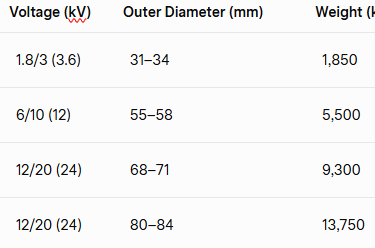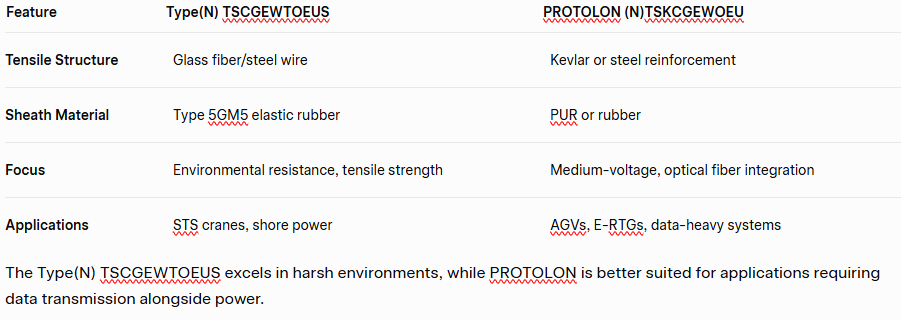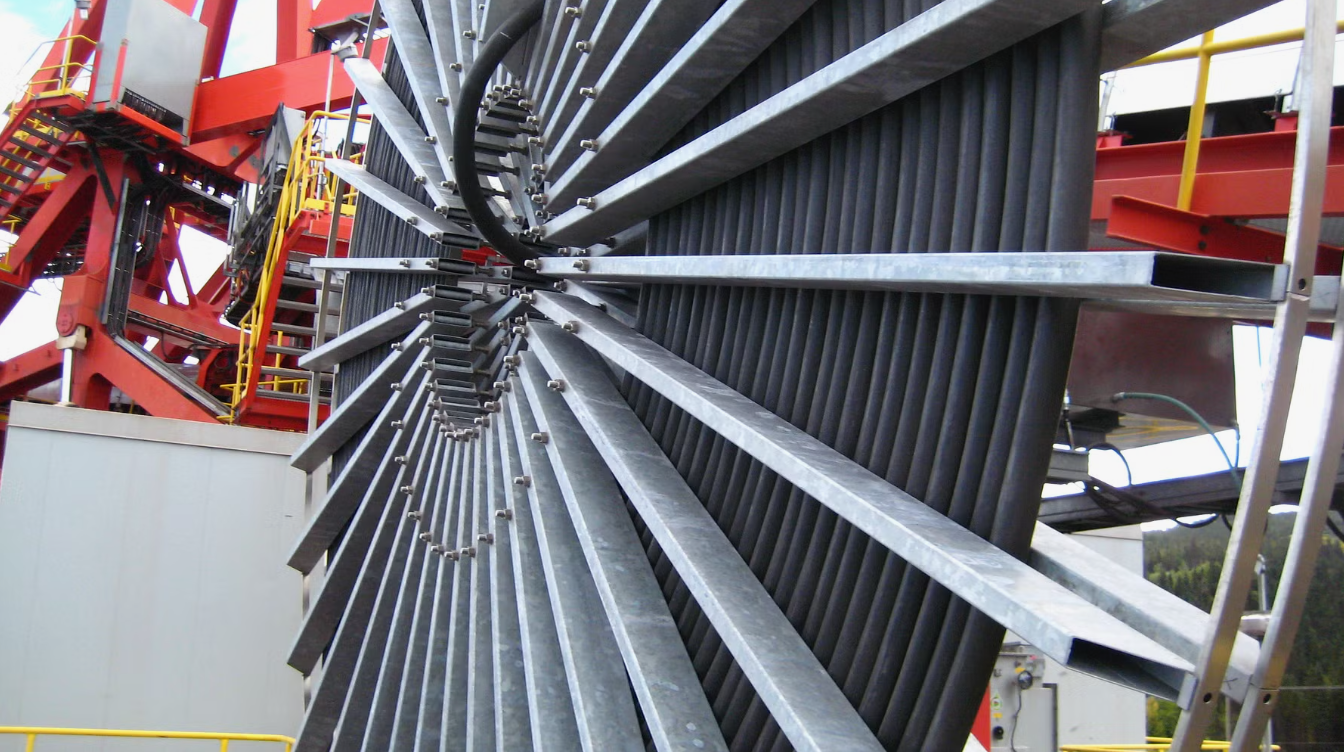📞+86 153 7530 2641 📧 hongjing.Wang@feichuncables.com

AS/NZS2802 Type(N) TSCGEWTOEUS Reeling Cable: Structure, Standards & Port Crane Applications
Explore the AS/NZS2802 Type(N) TSCGEWTOEUS reeling cable, designed for Australian port cranes and shore power systems. Learn its structure, compliance with VDE0250-814, IEC60245-6, and AS/NZS1747 standards, and why it’s ideal for the Port of Melbourne, Australia’s largest port, in harsh marine environments.
hongjing.Wang@Feichun
7/3/20255 min read
Introduction: The Backbone of Australian Port Operations
Australia’s ports are the lifeblood of its trade economy, with the Port of Melbourne leading the pack as the nation’s largest container port, handling over 3.3 million TEUs (twenty-foot equivalent units) in 2022. From the iron ore exports of Port Hedland to the diverse cargo of Fremantle, these hubs rely on advanced equipment like Ship-to-Shore (STS) cranes and shore power systems to keep goods moving. At the heart of these operations is the AS/NZS2802 Type(N) TSCGEWTOEUS flexible reeling cable, a high-performance solution designed to meet the rigorous demands of port environments.
Why is this cable so well-suited for Australian ports? Its robust structure, compliance with stringent standards like AS/NZS2802, VDE0250-814, and IEC60245-6, and adaptability to harsh coastal conditions make it a standout choice. This article explores the cable’s design, standards, applications in ports like Melbourne, Brisbane, and Fremantle, and answers common questions about potential issues, providing a comprehensive guide for port operators and engineers.


Standards Governing Type(N) TSCGEWTOEUS Reeling Cables
The Type(N) TSCGEWTOEUS cable adheres to a suite of standards that ensure its reliability and safety in port applications:
AS/NZS2802: This Australian/New Zealand standard outlines requirements for heavy-duty flexible towing and reeling cables, ensuring they can withstand mechanical stresses like bending and tension in port machinery.
VDE0250-814 / IEC60245-6: These German and international standards specify mechanical and electrical performance for elastic cables, focusing on flexibility, wear resistance, and tensile strength, critical for port crane reeling systems.
AS/NZS1747: This standard governs shore power supply systems, ensuring safe and reliable power delivery to berthed ships, reducing emissions and aligning with environmental regulations.
These standards collectively make the Type(N) TSCGEWTOEUS cable a trusted choice for Australia’s ports, ensuring compliance with both local and international safety and performance requirements.


Decoding the Type(N) TSCGEWTOEUS Model
The model name “Type(N) TSCGEWTOEUS” is a coded description of the cable’s properties and capabilities:
(N): Indicates compliance with German standards (Norm) for heavy-duty industrial applications.
TSCG: “TS” denotes trailing suitability, and “CG” highlights high flexibility for dynamic applications.
EWT: “EW” signifies extreme wear resistance, and “T” indicates adaptability to temperature variations.
OEUS: “O” for oil resistance, “EUS” for extra UV and sunlight resistance.
This nomenclature reflects the cable’s ability to handle the mechanical and environmental challenges of ports like the Port of Melbourne, where salt spray, UV exposure, and frequent reeling are common.


Cable Structure Breakdown
The Type(N) TSCGEWTOEUS cable is engineered with a multi-layered structure to ensure durability and performance:
Multi-strand Copper Conductor (VDE Class 5): Flexible copper strands provide high conductivity and flexibility, ideal for dynamic reeling applications.
Semiconductor Core Wire Shielding: Reduces electrical stress, enhancing insulation performance and safety.
EPR Elastic Insulation: Ethylene Propylene Rubber (EPR) resists heat, oil, and abrasion, ensuring long-term reliability.
Control/Monitoring Wire: Supports functions like temperature monitoring, critical for preventing overheating in high-load scenarios.
Ground Conductor (Double-Wire Spiral): Ensures safety by providing a fault current path, compliant with AS/NZS standards.
Middle Partition and Reinforcement: Glass fiber or steel wire reinforcement adds tensile strength, protecting inner components.
Outer Sheath (Type 5GM5 Elastic Rubber): Oil-resistant, wear-resistant, and UV-resistant, tailored for harsh port environments.
This structure ensures the cable can withstand the mechanical and environmental stresses of Australian ports, from Fremantle’s salty air to Melbourne’s high-throughput operations.
Technical Specifications
The Type(N) TSCGEWTOEUS cable is available in various configurations to meet diverse port needs. Key specifications include:


Bending Radius: Optimized for reeling, typically 6 x Ø on spools, ensuring flexibility without compromising durability.
Temperature Range: -25°C to +90°C, suitable for Australia’s coastal climates.
Environmental Adaptability: Resists salt spray, oil, and UV radiation, critical for ports like Brisbane.
Certifications: AS/NZS2802, VDE, CE, ISO9001, ensuring global quality standards.
These specifications make the cable versatile for high-voltage applications in dynamic port environments.
Why Type(N) TSCGEWTOEUS Fits Australian Ports
The Type(N) TSCGEWTOEUS cable is tailored for Australia’s ports, particularly the Port of Melbourne, due to:
STS Crane Compatibility: Its high tensile strength (up to 18,000 N) and bending life support the continuous operation of STS cranes, critical for Melbourne’s 3.3 million TEU throughput.
Shore Power Systems: Compliance with AS/NZS1747 ensures safe power delivery to berthed ships, reducing emissions in line with environmental goals.
Environmental Resilience: The UV-resistant, oil-resistant sheath withstands conditions in ports like Fremantle and Port Hedland.
Efficiency Gains: Its durability reduces maintenance downtime, boosting operational efficiency in high-throughput terminals.
Comparison to Similar Cables
The Type(N) TSCGEWTOEUS cable stands out when compared to alternatives like PROTOLON (N)TSKCGEWOEU:


Installation & Best Practices
To maximize the cable’s performance:
Reel Configuration: Maintain a minimum bending radius (6 x Ø on spools) and control winding speed to prevent stress.
Regular Inspections: Check for sheath wear, insulation integrity, and ground connections, using AS/NZS1747 guidelines.
Replacement Cycle: Plan replacements based on usage intensity, typically after millions of bending cycles, to avoid failures.
Pre-Failure Monitoring: Use temperature and electrical monitoring to detect early signs of wear, preventing downtime.


Questions and Answers: Addressing Potential Port Cable Problems
Q1: Why do port cables like Type(N) TSCGEWTOEUS fail prematurely?
Cables in ports like Melbourne may fail due to excessive bending, salt spray corrosion, or UV degradation. The Type(N) TSCGEWTOEUS’s robust sheath and reinforcement mitigate these issues, extending lifespan.
Q2: Is this cable suitable for all port applications?
It’s ideal for STS cranes and shore power at ports like Brisbane but may need customization for AGVs or data-heavy systems, where PROTOLON might be preferred.
Q3: How does it handle Australia’s marine climate?
The cable’s UV-resistant, oil-resistant sheath and -25°C to +90°C range ensure durability in ports like Fremantle, where salt and humidity are prevalent.
Q4: What maintenance is required?
Regular inspections for wear, insulation tests per AS/NZS1747, and proper storage prevent failures, especially in high-usage ports like Melbourne.
Q5: How to choose the right configuration?
Select based on voltage (e.g., 12/20 kV for high-power cranes), core size, and environmental needs. Consult suppliers for custom options like optical fibers.
Q6: Are there cost benefits?
Its durability reduces maintenance costs, and regional production offers competitive pricing compared to European alternatives.
Q7: Can it mitigate electromagnetic interference (EMI)?
The semiconductor shielding minimizes EMI, ensuring reliable performance in busy ports like Port Botany.
Procurement & Customization Tips
When sourcing the Type(N) TSCGEWTOEUS cable:
Confirm Specifications: Verify conductor size, sheath material, and shielding to match your application.
Customization Options: Add optical fibers for data, monitoring wires, or alternative sheaths (e.g., PUR) for specific conditions.
Certifications: Ensure AS/NZS2802, VDE, CE, and ISO9001 compliance for quality assurance.
Conclusion & Call to Action
The AS/NZS2802 Type(N) TSCGEWTOEUS reeling cable is a cornerstone for Australian ports, offering unmatched durability and compliance for STS cranes and shore power systems. Its robust design ensures reliability in the Port of Melbourne and beyond, supporting Australia’s trade efficiency. Port operators are encouraged to evaluate this cable for their projects and contact suppliers for samples or custom solutions to enhance terminal performance.
How to Reach Us
Get in Touch
SiteMap
Product Catalogue
Reeling Cable
Festoon Cable
Shore Power Cable




Scan to add us on WeChat
